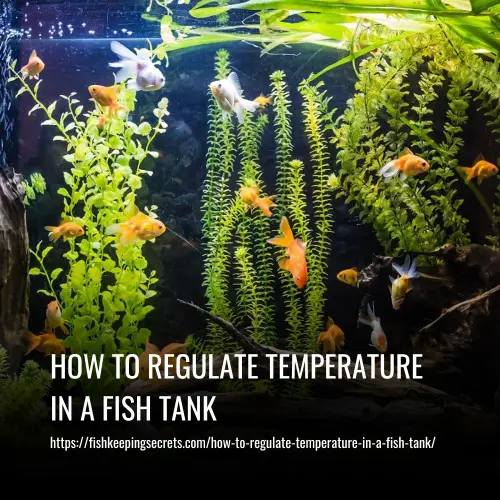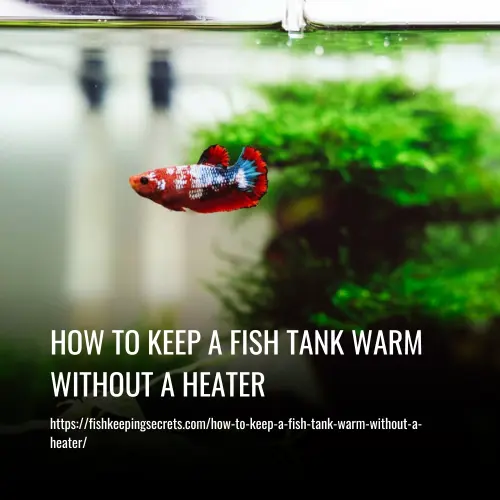How To Regulate Temperature In A Fish Tank
This post contains affiliate links. As an Amazon Associate, we earn from qualifying purchases.
Keeping the water temperature in your fish tank at the right level is crucial for the health and well-being of your aquatic pets. Fish are highly sensitive to changes in temperature, and fluctuations outside of their ideal range can significantly impact their immune system and overall health.
To regulate the temperature in a fish tank, follow these steps:
- 1. Turn off or Limit Aquarium Light
- 2. Prevent Direct Sunlight
- 3. Use Thermal Insulation
- 4. Position the Tank Properly
- 5. Use a Chiller
- 6. Monitor the Temperature

How To Regulate Temperature In A Fish Tank
Maintaining appropriate temperature levels in a fish tank is crucial for the health and well-being of your aquatic pets. Here are some tips to regulate the temperature in your fish tank:
1. Turn off or Limit Aquarium Light
Aquarium lights generate heat, which can raise the temperature inside the tank. Consider turning off the lights when not needed, or if you have a planted or reef tank, limit the number of hours the lights are on to minimize heat generation.
2. Prevent Direct Sunlight
If your fish tank is placed near a window, close the curtains or use blinds to block direct sunlight. Sunlight can quickly heat up the water, causing temperature fluctuations and potential stress to your fish.
3. Use Thermal Insulation
Insulating the sides and back of your aquarium can help maintain stable temperatures. You can use materials like styrofoam or insulating foam board to create a barrier between the tank and the surrounding environment.
4. Position the Tank Properly
Ensure that your fish tank is placed in a well-ventilated area. Good airflow helps dissipate excess heat. Avoid placing the aquarium near heat sources, such as radiators or air conditioners.
5. Use a Chiller
If you live in a warm climate or struggle with high room temperatures, consider installing a chiller in your aquarium. A chiller helps regulate water temperature by cooling it down when needed. Ensure the chiller is placed in a well-ventilated space to expel the excess heat it generates.
6. Monitor the Temperature
Regularly check the temperature of your fish tank using a reliable thermometer. Invest in a good-quality thermometer that can provide accurate readings. Keep an eye on any fluctuations and adjust accordingly.
By implementing these measures, you can effectively regulate the temperature in your fish tank, creating a comfortable and healthy environment for your aquatic pets.
Safe Temperature Range For Your Fish Tank
It is important to maintain a safe temperature range for your fish to ensure their well-being. For most species like Angelfish, Guppies, Mollies, and Silver Shark, a water temperature of 81 degrees Fahrenheit or 27 degrees Celsius is ideal. The Clown Loach, on the other hand, can tolerate warmer water up to 86 degrees Fahrenheit or 30 degrees Celsius.
However, prolonged exposure to temperatures higher than 86 degrees Fahrenheit or 30 degrees Celsius can be harmful to your fish. High temperatures can lead to a decrease in dissolved oxygen levels in the water, which can be dangerous for your fish. It is essential to have a good filtration system and increase aeration to maintain adequate oxygen levels in the water.
To prevent the water temperature from rising too high, it is recommended to perform more frequent water changes using slightly cooler water. This will help to bring down the temperature and ensure that oxygen levels remain sufficient for your fish.
Monitoring and maintaining a safe temperature range in your fish tank is crucial for the health and well-being of your fish.
Why Is Important To Keep A Stable Temperature In A Fish Tank
Maintaining the right temperature in your fish tank is crucial for the well-being of your fish. Fluctuations in temperature can lead to various problems, including algae growth, plant decay, increased bacteria growth, changes in water oxygenation levels, and disrupted fish metabolism.
1. Algae Growth and Plant Decay
When the temperature changes too much or too quickly, it can lead to the growth of algae and decay of plants in your tank. This can disrupt the chemical balance of the tank and negatively impact the overall health of your fish. It is important to regulate the temperature to prevent these issues.
2. Bacteria Growth and Fish Illness
Temperature fluctuations can also lead to increased bacteria growth, which can be harmful to your fish. Excessive bacteria growth can result in fish illnesses and even fatalities. Maintaining a stable temperature will help control bacteria levels and reduce the risk of your fish getting sick.
3. Water Oxygenation Levels
Temperature changes can affect the oxygen levels in the water. Warmer water holds less dissolved oxygen, while colder water holds more. If the temperature fluctuates too much, it can disrupt the oxygenation levels in the tank, which can be harmful to your fish. It is crucial to ensure the temperature remains stable to provide sufficient oxygen for your fish.
4. Fish Metabolism and Feeding Needs
The metabolism of fish is affected by temperature. When the water is too cold, their metabolism slows down, and they may eat less. On the other hand, when the water is too warm, their metabolism speeds up, and they may require more food. Stable temperature is important to ensure your fish’s feeding needs are met.
5. Breeding Readiness
Temperature also plays a role in the breeding readiness of different fish species. Some species require specific temperature ranges to trigger their breeding behaviors. Fluctuations in temperature can disrupt the breeding readiness of these fish. Maintaining a stable temperature can ensure that your fish have the optimal conditions for breeding if desired.
Factors That Affect Fish Tank Temperature
Maintaining the right temperature in a fish tank is vital for the health and well-being of the aquatic environment. Several factors can influence the tank’s temperature, including room temperature, lighting, tank location, and tank size.
1. Room Temperature
It’s important to consider the room temperature when regulating the tank’s temperature. If the room temperature is consistently warm, it can cause the aquarium to overheat. To prevent this, it’s recommended to keep the tank away from windows that may expose it to direct sunlight, leading to temperature fluctuations. Using a thermometer can ensure that the room temperature remains consistent, allowing for accurate temperature control.
2. Lighting
The type and intensity of lighting used in the fish tank can affect its temperature. High-intensity lighting can significantly increase the temperature inside the tank. To regulate the temperature, using LED lights instead of traditional incandescent bulbs can be helpful. Additionally, considering the frequency and duration of light exposure can help manage the tank’s temperature effectively.
3. Tank Location
The location where the fish tank is placed can impact its temperature regulation. Exposing the tank to direct sunlight, drafts, or temperature fluctuations can affect the tank’s temperature. It’s best to position the aquarium in a room with a consistent room temperature to ensure temperature stability. Avoid placing the tank near heating and cooling vents, as it can result in drastic temperature fluctuations.
4. Tank Size
The size of the tank also plays a role in temperature regulation. Larger tanks require more heating or cooling, and it can be more challenging to maintain a consistent temperature. The volume of water in the tank influences its temperature stability, so it’s important to consider the tank size when managing temperature. Proper placement of the heater or cooler should be ensured to achieve even distribution of temperature throughout the tank.
By considering and addressing these factors, fish owners can successfully regulate the temperature in their tanks, providing a healthy and comfortable environment for their aquatic pets.
Advice For Maintaining Aquarium Heaters
Maintaining an aquarium heater is crucial for the well-being of your fish and the overall health of your tank. Here are some tips to help you keep your aquarium heater in good condition:
1. Choose the Right Type of Heater
There are both submersible and hang-on heaters available. Submersible heaters are water-tight but are generally more expensive. Hang-on heaters are less expensive but may not be as durable. Consider the needs of your tank and choose the heater that suits your requirements.
2. Set the Temperature Correctly
Most heaters are thermostatically controlled and allow you to set specific temperatures. Some heaters require trial-and-error adjustments, while others have precise temperature settings. Ensure that your aquarium is stable at the desired temperature to create a suitable environment for your fish.
3. Consider Wattage for the Tank Size
The wattage required for your heater depends on the size of your tank and the room temperature. As a general rule, for normal room temperatures, use 100 watts for a 20-gallon tank, 175 watts for a 55-gallon tank, and 300 watts for a 100-gallon tank. Adjust the wattage accordingly if the room gets colder.
4. Maintain Stable Water Temperature
It is essential to ensure that the water temperature in your tank remains stable. Sudden temperature fluctuations can stress your fish. Monitor the water temperature regularly and make adjustments if necessary.
5. Use Multiple Heaters for Larger Tanks
In larger tanks, it may be beneficial to use two heaters that collectively provide the required wattage. This way, if one heater malfunctions or fails, the other can help maintain the temperature until the issue is resolved. This can prevent the water from overheating or rapidly cooling down.
6. Consider Placement in Sumps or Plumbing Circuits
If your tank has a sump or a plumbing circuit, it can be advantageous to place the heater in these areas. This helps to maintain a consistent and even distribution of heat throughout the tank.
By following these tips, you can ensure that your aquarium heater functions properly, providing a comfortable and stable environment for your fish.
What To Do When Your Tank Overheats
During hot weather, it’s crucial to take steps to cool down your fish tank if it overheats. Here are some actions you can take:
1. Increase Water Movement
The warmer the water gets, the less oxygen it can hold. Increasing water movement in your tank can help pick up more oxygen and also promote evaporation, which in turn cools down the water. Remove the normal aquarium top and replace it with screening to allow for better airflow. Position a fan to blow across the water surface to further enhance evaporation. Keep in mind that you’ll need to top off the tank frequently to replace evaporated water.
2. Use Frozen Water Bottles
Another method to cool down the water is to freeze water in plastic bottles and place them in the tank or filter. This slowly releases cooler water into the tank, helping to lower the temperature. It’s important to use bottles that are small enough so that the water doesn’t cool too quickly or dramatically, as extreme temperature changes can be harmful to your fish.
3. Consider a Chiller
If your home consistently remains very hot for extended periods, you might need to invest in a chiller for your aquarium. There are drop-in models that hang on the tank rim and chilling coils are directly immersed in the aquarium. Alternatively, there are external chillers that require a pump to circulate water from the tank through the chiller and back.
4. Pay Attention to Reef Aquariums
Reef aquariums are particularly sensitive to temperature changes. Marine invertebrates, which are commonly found in reef setups, are unable to tolerate prolonged periods of high temperatures. Chillers are commonly used in reef aquariums to maintain stable and cooler conditions. Additionally, chillers offer the opportunity to keep cool-water fish and invertebrates, whether they are freshwater or marine species.
Remember to monitor the temperature of your fish tank regularly, especially during hot weather, and take appropriate measures to ensure the well-being of your aquatic pets.
How To Raise Your Fish Tank Temperature If It’s Too Cold
If you find that your fish tank temperature is too cold, there are several methods you can use to raise it:
1. Turn on the Lights
Turning on the lights in your aquarium can help generate some heat and raise the temperature slightly. However, this method may not be sufficient on its own for significant temperature increases.
2. Adjust the Heater
If you have a heater in your aquarium, you can increase the temperature setting to raise the overall temperature of the tank. Make sure to adjust it gradually and monitor the temperature to avoid sudden changes that can stress your fish.
3. Utilize Natural Sunlight
If your aquarium is near a window, opening the curtains can allow sunlight to enter. Sunlight can provide some warmth, helping to raise the temperature of the tank. However, be cautious of excessive sunlight exposure, as it can lead to algae growth or temperature fluctuations.
4. Perform a Water Change
Doing a water change with slightly warmer water can help increase the tank’s temperature. Before adding the water, check its temperature to ensure it is suitable for your fish. Avoid raising the temperature by more than 2-3 degrees Fahrenheit at once to prevent shocking your fish.
Remember to monitor the temperature regularly and make adjustments as needed to maintain a stable and comfortable environment for your fish.
How To Check Your Fish Tank Temperature Without A Thermometer
Checking the temperature of your fish tank without a thermometer can be challenging, but not impossible. Here are a few methods you can try:
1. Use Your Hand
Dip your hand into the water and feel if it is warmer or colder than usual. While this method is subjective and can vary from person to person, it can give you a general idea of whether the temperature has changed significantly. However, it is not as accurate as using a thermometer.
2. Observe Your Fish
Fish are extremely sensitive to changes in temperature. If you notice your fish behaving differently, such as being more active, seeking warmer or cooler areas of the tank, or showing signs of stress, it could indicate a temperature change. While this method is not precise, it can give you a clue about potential temperature fluctuations.
3. Monitor Other Signs
Pay attention to other signs that may indicate a temperature change, such as condensation on the tank walls, fluctuating water levels, or changes in the behavior of your aquarium equipment. These signs may suggest that the temperature is either too high or too low.
While these methods can provide some insight into the temperature of your fish tank, they are not as accurate as using a thermometer. Investing in a thermometer specifically designed for aquariums is the best way to ensure you have accurate and reliable temperature readings.
FAQs
The best temperature for a fish tank is typically between 24 and 26.5 degrees Celsius (75-80 degrees Fahrenheit). Most common fish species found in home or business aquariums thrive in this temperature range.
To maintain a constant temperature in your tank, invest in a high-quality heater. Place the heater in the middle of the tank for optimal results and to ensure that the temperature remains stable. Make sure that you choose the right type of heater for the size of your tank.
You can use a thermometer specifically designed for fish tanks to check the temperature. If the temperature is higher than 82°F or lower than 75°F (for tropical fish), it may be too hot for your fish. For goldfish, the ideal temperature range is 62°F to 74°F. If the temperature is off, you can use a heater to warm up the tank or a cooling system to bring the temperature down.
The best temperature for corals is around 80°F. They can tolerate temporary cooling better than heating. Lighting and pumps can generate heat, so it’s important to have a chiller to counteract hot temperatures. Chillers can be expensive, but they are worth it to prevent heat buildup and protect your corals. Carefully selecting and placing lighting and pumps can also help prevent temperature issues.
To keep your water tank cool in the summer, you can cover it with a shed or some sort of shade structure to protect it from direct sunlight. This will help minimize the amount of heat absorbed by the tank and keep the water inside cool for your needs during hot summer days.
The best place to put a thermostat in a fish tank is near areas with good water flow. This could be near the outlet of a filtration system or near a water pump. Proper water circulation is important for maintaining consistent temperatures throughout the aquarium.
The optimum temperature for your aquarium during the summer depends on the type of fish you have. Freshwater fishes like Danios and Black Molly do well in temperatures between 23 and 26 degrees Celsius. Other fish, like the Paradise Fish, can tolerate temperatures between 15 and 20 degrees Celsius or lower. Make sure to adjust the temperature accordingly to keep your fish comfortable and healthy during the summer.
It is not recommended to put ice cubes directly into a fish tank. While a couple of ice cubes may be used in small betta and nano tanks to maintain cooler water, it is important to condition the water before freezing it to avoid releasing toxic chlorine into the tank as the ice melts.
For most freshwater fish, a temperature range of 72ºF – 82ºF is recommended for their tank. However, some fish can tolerate slightly cooler temperatures, such as 67°-70°F. It’s important to research the specific temperature requirements for the fish you have in your tank to ensure their well-being.
Most tetras prefer a temperature between 75°F and 80°F. It’s important to maintain the correct temperature in your aquarium, especially if the room temperature falls below 75°F. Using an Aqueon Aquarium Heater can help ensure the water stays within the ideal temperature range. Some tetras, like the Buenos Aires tetra, may do better in cooler water.
Adding warm water directly to a fish tank can be harmful to the fish. Sudden changes in water temperature can cause stress and even lead to disease or death. It’s important to gradually adjust the temperature of the water when needed to ensure the well-being of the fish.
Keeping a stable temperature is vital for your fish’s health. Fish are cold-blooded creatures, so their body temperature changes according to their environment. Maintenance of temperature provides stable conditions that support healthy growth and metabolism.
Yes, temperature fluctuations can cause severe stress on your fish. Too high or low temperatures can result in metabolic disorders, weakened immunity, and greater susceptibility to disease. Therefore, maintaining stable and optimal temperature conditions is essential.
Check your fish tank temperature at least once a day and preferably at the same time. Regular temperature checks will prevent sudden fluctuations, ensure your fish remain healthy, and help you detect equipment failures early.
If the temperature is too high, turn off all heaters, reduce the water level, and increase aeration to help cool the water. If the temperature is too low, restart your heater, add more blankets around the aquarium, and insulate it from drafts to conserve heat.
Conclusion
In conclusion, maintaining the proper temperature in a fish tank is crucial for the health and well-being of the aquatic life. By using a reliable and accurate thermometer, choosing an appropriate heater and adjusting the room temperature, fish owners can create a stable and comfortable environment for their pets.
It’s also important to monitor the temperature regularly and make any necessary adjustments to prevent sudden fluctuations. Taking the time to properly regulate the temperature in a fish tank can help ensure that the fish remain healthy and thrive in their aquatic habitat.






